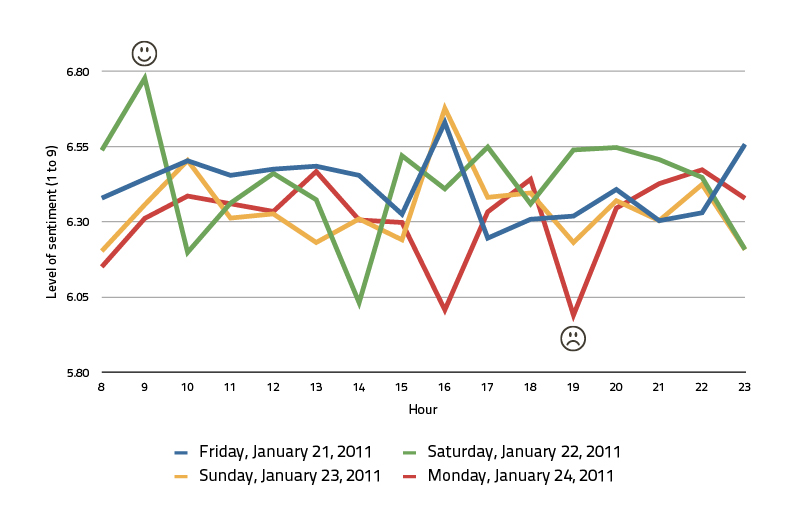If you’re running a small business, then you probably don’t have a problem keeping up with your Twitter account. Large companies, on the other hand, receive volumes of social media coverage. According to Burson-Marsteller, Fortune 100 companies are mentioned an average of 55,790 times per month on Twitter.
Marketing departments take a strong interest in measuring their brands’ “Twitter temperature,” so they turn to automated sentiment detection programs. Instead of reading through all of their tweets and mentions the way that a small business owner might do, a marketing professional may activate an automated sentiment detection program and look at a graph. That graph would indicate how many of those 55,790 tweets were positive and how many were negative. The tool would be particularly useful when the company rolled out a new promotion or product.

“Business intelligence,” which encompasses understanding brand sentiment on social media, has gotten so big that some universities offer degrees in it. Look over at this website to see an example of an online business intelligence program. A business intelligence tool like automated sentiment detection software may look like a real timesaver on the surface. However, no company can allow its marketing or customer service team to rely on it too heavily.
How Sentiment Detection Works
Automated sentiment detection software analyzes tweets and other social media posts according to algorithms based on linguistic and contextual rules. However, anyone who’s had a conversation with Siri lately knows that computers’ understanding of human language input has a long way to go. Automated sentiment detection has a number of limitations, including:
- Difficulty with nuanced expressions. Many of these programs have a difficult time interpreting slang, irony and sarcasm. One company called Spotter recently issued an automated detection program that it claimed was capable of detecting sarcasm, but it only claims an accuracy rate of 80 percent.
- Inability to understand geographical variations. People from different geographic areas utilize unique vernacular expressions even if they speak the same language. Sentiment detection can’t always understand these colloquialisms.
- Cannot process languages other than English. Most automated detection programs only analyze English posts. Citizens of the Earth use approximately 7,000 different languages.
- Poor understanding of context. A phrase like “Charles Manson Gets a Samsung Galaxy S4” probably won’t impress the Samsung marketing team. However, most automated sentiment detection programs wouldn’t interpret the name “Charles Manson” negatively.
Should Marketing Teams Rely on Sentiment Detection Tools?
If your company is mentioned in over 50,000 tweets per month, your customer service team will never have the kind of manpower to manually sift through those tweets. Automated tools deliver a much-needed shortcut through the data. When you’re using them or training your staff to use them, keep these guidelines in mind:
- Prioritize certain features. Your tool should enable you to reclassify sentiments that are interpreted incorrectly, and the tool should have the capacity to learn from its mistakes. Additionally, you should be able to optimize the tool for your vertical or your industry, and you should be able to combine content and user rankings to prioritize the mentions that you receive.
- Think aggregate. You can explore tools that dig down into short-term results, but automated sentiment detection does a better job of interpreting trends. If you see a negative trend within 24 hours, then keep watching, but don’t worry. If negativity trends over three months, then you should be concerned.
- Utilize keywords for deeper analysis. A sentiment analysis of one large retailer back in 2009 showed a 2-to-1 ratio of positive to negative comments. However, when the keywords “labor and workforce policies” were added to the analysis, the positive to negative ratio became 1-to-1. Your teams should put sentiment in context to better understand how customers perceive your brand.
Automated sentiment detection tools are useful, but they can’t replace one-on-one customer interaction. If your team is unsure whether “Thanks for the great customer service!” is kindly meant or sarcastic, then take the time to reach out to the person that sent the tweet. Your appreciation can turn a positive tweeter into a brand evangelist. Likewise, your conscientiousness can stop negativity before it gets out of control.
Graph image from Flickr’s Creative Commons by robhawkes
About the Author: Leah Capistrati provides social media marketing consulting services to a range of companies from small businesses to large enterprises.



